Part of Wine Lister’s Brand score includes a measure of prestige, achieved by analysing a wine’s presence in the world’s best restaurants. Whether a restaurant makes the cut depend on a combination of measures including the Michelin Guide, San Pellegrino 50 Best Restaurants, and World of Fine Wine Best Wine List Awards.
The chosen wine lists are then analysed to give us the breadth (how many restaurants) and depth (how many formats and/or vintages in each restaurant) of presence achieved by each wine on Wine Lister. Looking at the former criterion, the chart below shows the top 20 biggest gainers since our last blog on the subject. (Next week we will be looking at wines with the greatest increase in depth of representation.)
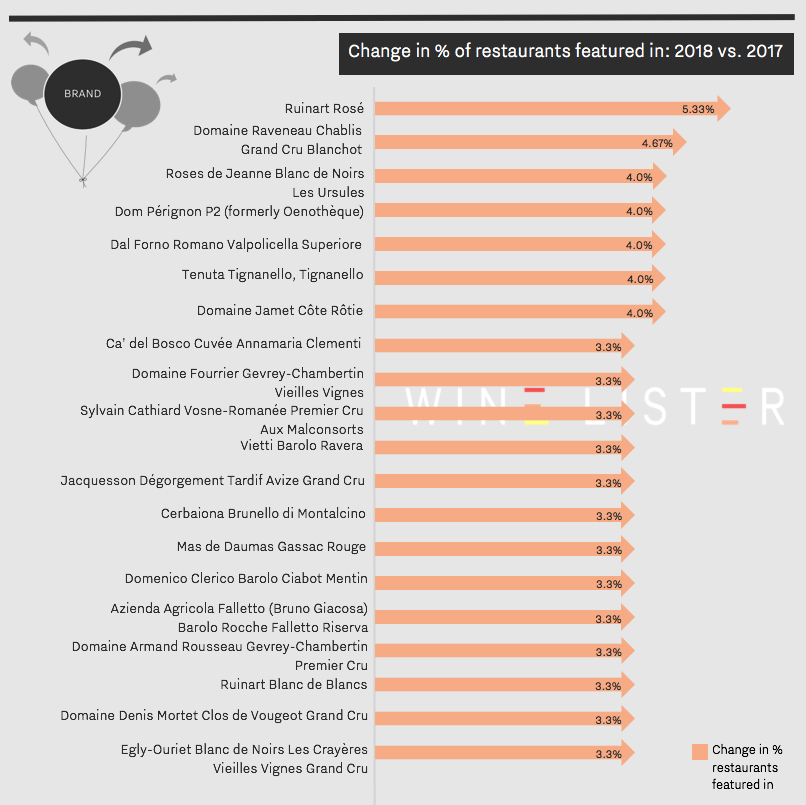
Six out of the 20 wines with the biggest increase in restaurant presence are Champagnes. Ruinart appears twice, with its NV rosé having made the greatest improvement, now appearing in 33% of the world’s best restaurants. However, the overall winner – present in more than double the number of restaurants, is Dom Pérignon’s Vintage Brut. Despite not featuring in the top 20 biggest risers above, the Champagne Brand king is now present in 69% of top restaurants worldwide, overtaking last year’s winner, Yquem.
Contrary to our last analysis on the subject, not all the biggest Champagne gainers in restaurant presence are big brands. Ruinart Rosé, Dom Pérignon P2, and Ruinart Blanc de Blancs may well fit this bill, with an average Brand score of 878, but the lesser-known three, grower Champagnes Roses de Jeanne Blanc de Noirs Les Ursules, Jacquesson Dégorgement Tardif Avize Grand Cru, and Egly-Ouriet Blanc de Noirs Les Crayères Vieilles Vignes, do not, as shown by a lower collective Brand score average of 664.
If this alone is not an indication of restaurant wine lists branching out, then perhaps the absence of Bordeaux is (indeed, a handful of Bordeaux wines with strong restaurant presence have lost a little ground since last year’s analysis). This diversification does however appear exclusive to the Old World, with no New World wines in the top 20 gainers.
Burgundy is well-represented amongst the top gainers, with one white, Raveneau’s Chablis Blanchot, and four reds: Sylvain Cathiard’s Vosne-Romanée Aux Malconsorts, Denis Mortet’s Clos de Vougeot, Armand Rousseau’s Gevrey-Chambertin, and Fourrier’s Gevrey Chambertin Vieilles Vignes.
Italy brings a show of diversity with six wines hailing from four different appellations across the 20 biggest movers. Vietti’s Barolo Ravera – one of three Barolos to feature in this list – has the lowest restaurant presence of the group (5%) and Solaia’s younger sibling, Tignanello the highest (47%).
The 2018 will be a five-star vintage for Chianti Classico wines according to Giovanni Manetti, newly-elected president of the appellation’s Consorzio. The growing season was “very regular”, with no extreme weather events, and normal picking times. Thanks to healthy grapes, ripe yet fresh, Manetti believes the vintage will be characterised by “harmony”. The DOCG appellation is set to produce c.270,000 hectolitres, back to normal production levels after a less abundant 2017.
On Monday 24th September at Fontodi, Manetti’s winery in Panzano, harvest was well underway. It had not rained for 22 days, and the ground was dusty. However, Manetti explained that in Panzano, while hot, temperatures had not risen above 36˚C, and that nights had been cool. At Castello di Fonterutoli, 15km further south, Giovanni Mazzei confirmed the heat had been nothing on 2015, when temperatures rose above 45˚C.
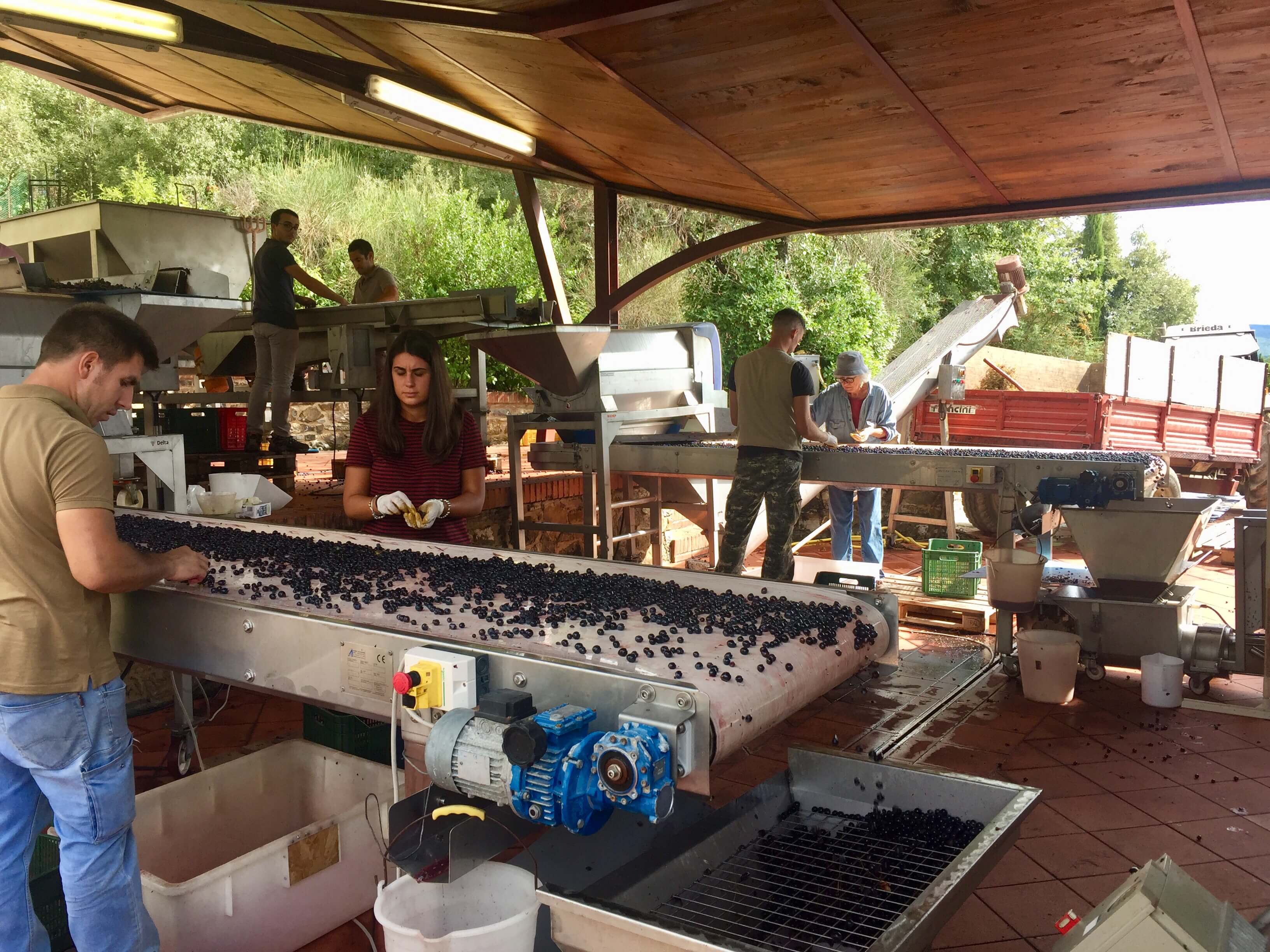
Quality control at Fontodi’s sorting tables in Chianti Classico
However, Mazzei was somewhat less sanguine about the 2018, citing humid mornings as a challenge. Having picked one third of the estate’s production by Monday, the next fortnight will be a race against rot. Mazzei predicts the vintage might fall between the opulent 2015s and the structured 2016s in terms of quality and style.
Towards the coast, in Bolgheri, the Merlot harvest is almost finished, and “the fermenting wines are silky and fragrant,” according to Axel Heinz, Estate Director at both Ornellaia and Masseto. Heinz is grateful for “excellent conditions during September with sunny and mostly dry weather, occasionally hot day temperatures but cool nights”. In Bolgheri, “mildew and humidity have been challenging,” he states, ”but we were able to bring healthy fruit to full ripeness,” recounts Heinz, who says yields in 2018 are normal. He predicts “a more delicate vintage, like 2013.”
Moving down the coast, in the Maremma, Elisabetta Geppetti, owner of Fattoria Le Pupille, spoke of regular climatic conditions leading to “a good year”. The first lot of Merlot for Geppetti’s flagship wine Saffredi is already vinified, and, she says, “marvellous”. She is delighted with her Cabernet Sauvignon too, and relayed the view of Le Pupille’s consultant oenologist Luca d’Attoma, that the grape has thrived throughout the whole southern part of Tuscany. Meanwhile Sangiovese has ripened less evenly.
Back inland, in Sangiovese’s heartland, Montalcino, the picture is less clear cut, due to excessive rain in spring and early summer. “Winemakers had not seen this kind of weather since the nineties,” explained Giacomo Pondini, Director of the Brunello di Montalcino Consorzio.
There has been “too much humidity in the air”, according to Gianfranco Soldera, with an “almost tropical” summer (a similar story to the picture recounted in our Bordeaux harvest report). At Case Basse, Soldera’s cult winery, 2018 has been “a year of suffering”, with mildew, oidium, and “mould in general”. To combat this, a team of 20 people has been combing the vineyard removing bunches non-stop since June.
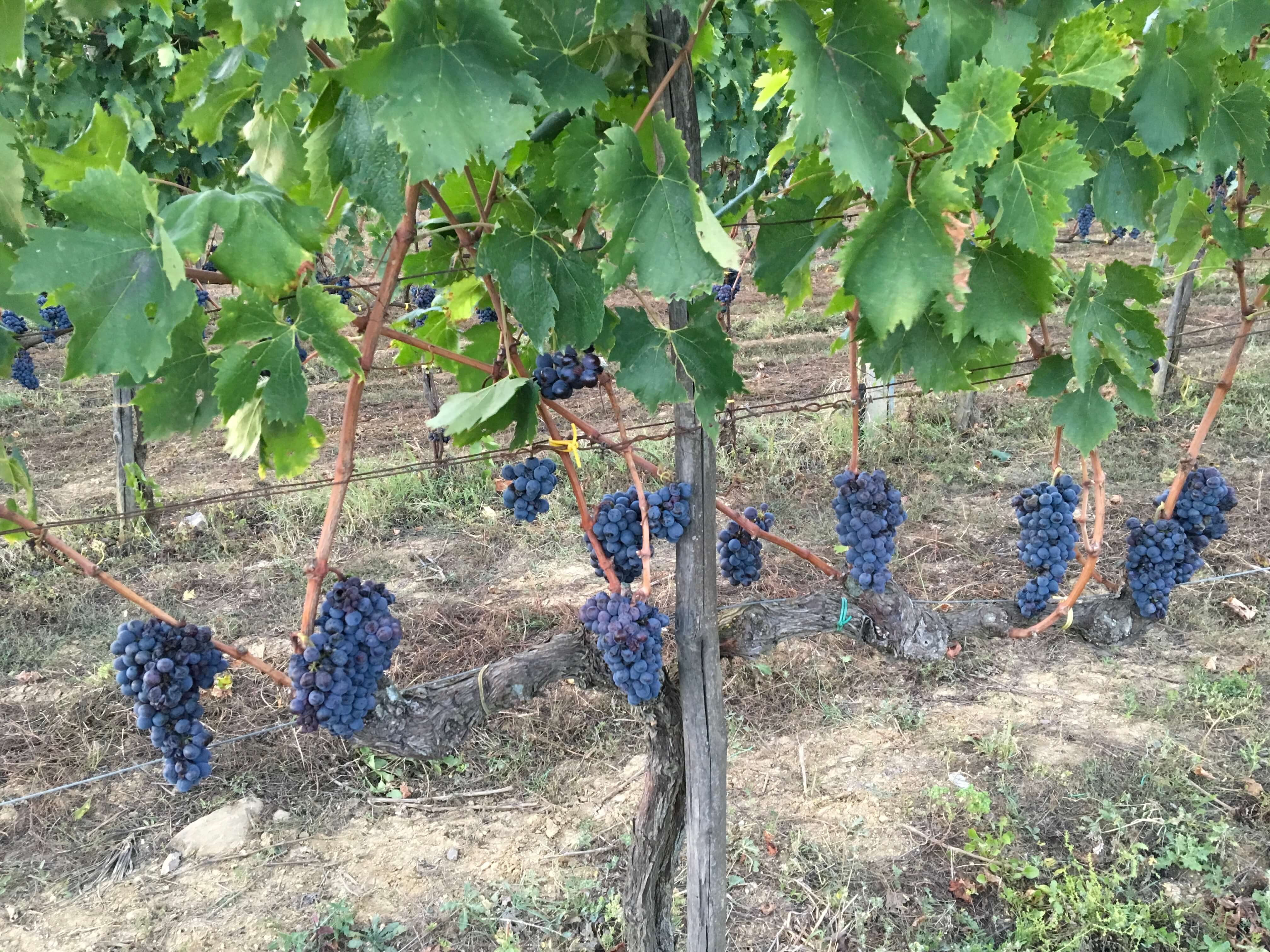
Remaining bunches after extreme selection at Soldera’s Case Basse in Montalcino
Unlike in 1989, the only year when Soldera didn’t make a wine because of too much rain, he was “ready for the challenge” this time round, and believes he will still make a great wine in 2018, albeit in very small quantities. For Soldera, rain is the enemy of vine-growing, and he rejoiced in the exceptionally dry growing season of 2017, “a year of fun”, where the vines drank mineral-rich water from the ground. Incidentally, the 2017, tasted (or rather drunk – as spitting is banned at Case Basse) from its Garbellotto cask, is incredible: alluring, alive, pure, and long.
The owner of neighbouring wineries Caparzo and Altesino, Elisabetta Gnudi puts 2018 somewhere between a four- and five-star vintage. To absorb the humidity, her team used clay dust on the vines, “like using baby powder,” she explained. Again echoing the story in Bordeaux, she reckons that “true organic vineyards haven’t harvested a single grape this year.”
At Argiano, Sales Manager Riccardo Bogi also described a less plain-sailing vintage than in Chianti. On top of the heavy rain, a hailstorm in July wiped out 25% of the crop in some vineyards. However, positioned high up on the hill of Argiano, wind in August meant the winery was able to counter rot with copper and sulphur, although the “agronomist didn’t get a vacation”, quipped Bogi. Like Heinz in Bolgheri, he expects 2018 to share characteristics with the elegant 2013s, saying they won’t have intense colour or structure.
There was a dramatic change in the weather on Monday, with temperatures dropping and strong winds picking up, which lasted throughout our three-day visit. While half of the appellation’s Sangiovese has already been harvested, and wineries are “happy with the quality,” Pondini hopes that, “the other half may benefit from this sunny, cool, windy week”.
Buzz Brands are wines that are sure to turn heads, destined to cause a stir whenever they are opened. They combine excellence across Wine Lister’s two Brand criteria – restaurant presence and online popularity – whilst also being held in the highest regard by the fine wine trade – as confirmed by Wine Lister’s Founding Members’ survey which gathers the opinions of around 50 key players in the international wine trade. This week, the Listed section focuses on Italy’s top five Buzz Brands by overall Wine Lister score.
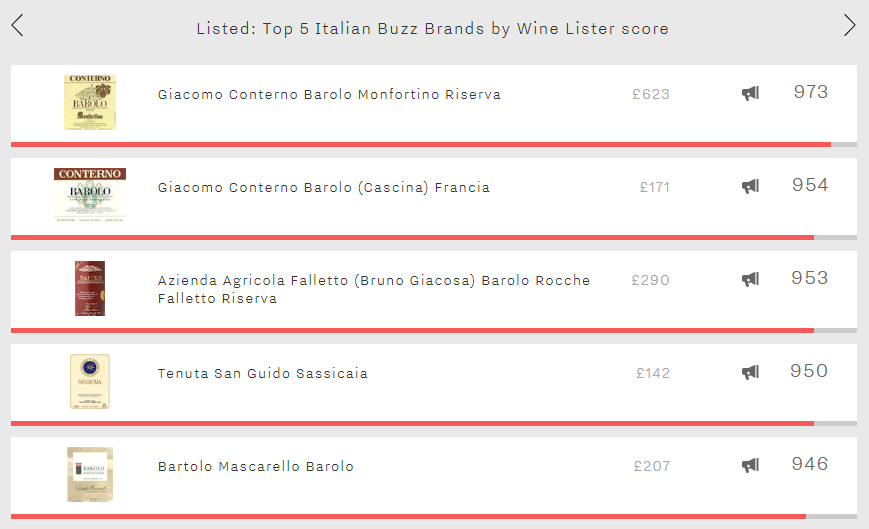
Barolo is home to four of Italy’s top five Buzz Brands, two of which are produced by Giacomo Conterno – the flagship Monfortino in first place (973) and Francia not far behind in second place (954). The Monfortino achieves Italy’s best Quality score (977), the result of remarkable consistency from vintage to vintage, having achieved a score of 993 or above in seven of the past 10 vintages. Its best ever vintage was 2004 (998), thanks to a perfect 100-point score from Antonio Galloni, who writes: “I imagine the 2004 Monfortino will give readers an utterly spellbinding drinking experience for the next few decades”.
Whilst the Francia is pipped at the post in each category by its illustrious stablemate (trailing by 17 points in the Quality category, 11 in the Brand category, and 34 in terms of Economics), it does manage superior restaurant presence, visible in 30% of the world’s top establishments, compared to the Monfortino’s 23%. This is presumably due to over three times as many bottles of it being produced each year on average.
In third place is Azienda Agricola Falletto’s Rocche Falletto Riserva (953). It records the best Economics score of the five (969) and Italy’s second-best, beaten only by Falletto’s Barbaresco Asili Riserva (978). It does so thanks to the combination of very strong growth rates – it has recorded a three-year compound annual growth rate of 21% and has added 8% to its value over the past six months alone – and strong liquidity – its top five vintages having traded 398 bottles at auction over the past year. Perhaps collectors have been eager to get their hands on a bottle after the passing of Bruno Giacosa in January.
Proving that Super Tuscans can mix it with Piedmont’s top nebbiolos, Sassicaia takes fourth place. Whilst it cannot keep pace with Barolo’s finest in the Quality and Economics categories, Sassicaia stretches out a comfortable lead in the Brand category thanks to an extraordinary score of 998. This near-perfect score puts it alongside Haut-Brion, Margaux, and Petrus, beaten only by the Pauillac First Growths, Dom Pérignon Vintage Brut, and Yquem. Its brand dominance is the result of outstanding restaurant presence (49%) and online popularity – receiving well over three times as many searches each month as Conterno’s Monfortino, which is the group’s second-most popular wine.
Rounding out the five is Bartolo Mascarello’s Barolo. Its brand is its strongest asset, its score of 964 making it Barolo’s second-strongest brand behind Conterno’s Monfortino. Despite receiving over 20% fewer online searches each month than the Monfortino, it matches its level of restaurant presence – perhaps the azienda’s famous “no barrique no Berlusconi” message strikes a chord with sommeliers.
Ornellaia 2015 has been released at £150 per bottle. The factsheet below summarises its key points.
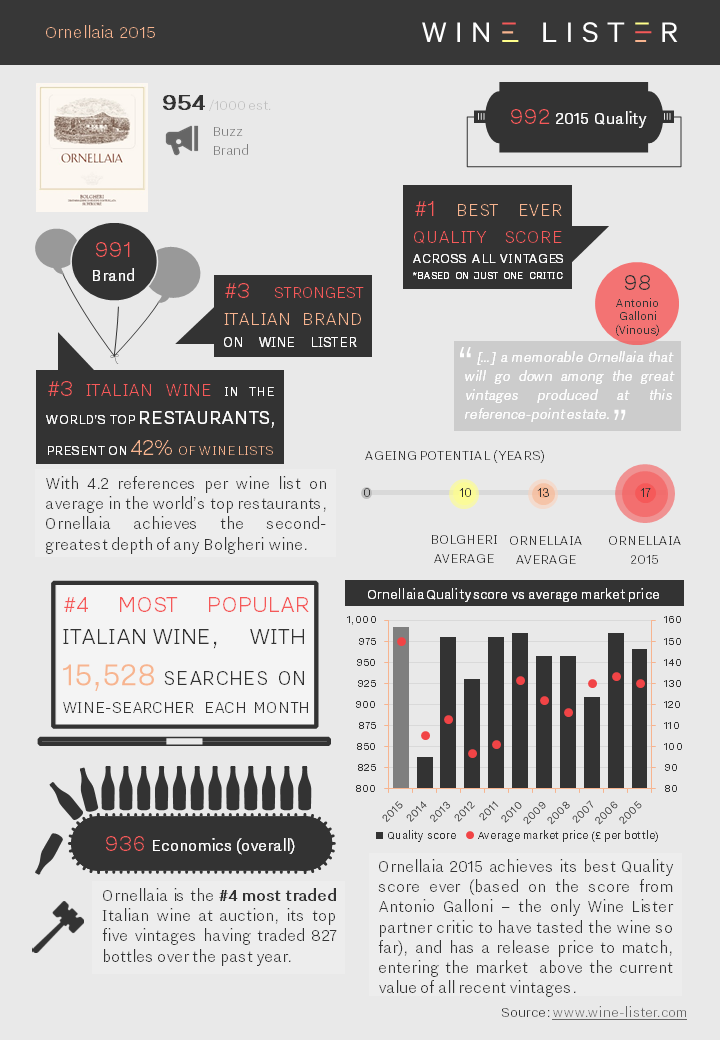
You can download this slide here: Wine Lister Factsheet Ornellaia 2015
What do you do when your drinking tastes far outweigh your wine budget? You could trawl the shops and the internet in search of that bottle that combines high ratings and moderate prices, or alternatively you could use Wine Lister’s Value Picks search tool. It selects top quality wines that are available at reasonable prices, doing the legwork for you. This week’s Listed section shines a spotlight on the top five reds that currently qualify as Value Picks. At present, they are all Tuscan, all available for under £90 – in fact all but one cost less than £50 – and all have Quality scores of over 990, putting them amongst the elitest of the elite on Wine Lister’s 1,000 point scale.
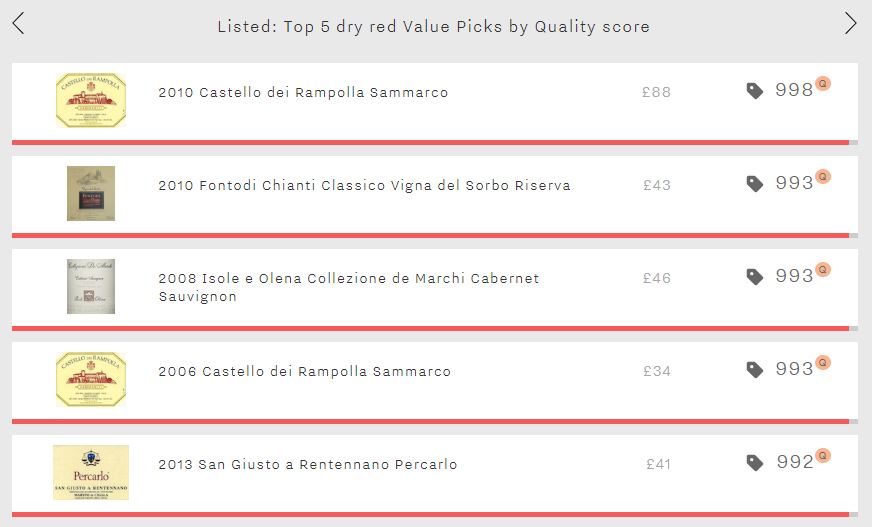
If you are after exceptional value, then look no further than Castello dei Rampolla’s Sammarco. With two vintages in the top five (2010 and 2006), each of which have plenty of life still left in them, they look like wise purchases. The 2010 owes its exceptional Quality score to a perfect 100-point rating from Wine Lister partner critic Antonio Galloni, who called it “stunning as it has always been. In a word: magnificent!”. At £88 per bottle, it might not be the cheapest, but it does look good value compared to the two other 998-point scorers from Tuscany 2010: Cerbaiona Brunello di Montalcino (£248) and Castello dei Rampolla’s Alceo (£128).
Whilst the 2010 is not quite ready to drink, the 2006 has just entered its drinking window. Underlining the wine’s longevity, Galloni, who awarded the wine a 97-point score, remarked: “Readers will have to be exceedingly patient here. There is no denying the 2006’s greatness, though.” The 2006 will be drinking well until 2036, and available for as little as £34 per bottle, looks like an excellent long-term investment (if you can refrain from opening it).
Flying the flag for Chianti is Fontodi’s best ever Chianti Classico Vigna del Sorbo Riserva – the 2010 (£43). Whilst its Quality is not in doubt, its economic performance is slightly less impressive, its price having fallen 11% over the past six months.
The remaining spots are filled by Isole e Olena Collezione de Marchi Cabernet Sauvignon 2008 (£46) and San Giusto a Rentennano Percarlo 2013 (£41). Isole e Olena Collezione de Marchi 2010’s Quality score is the furthest above its wine-level average Quality score (993 vs 934) of the five. The market has not yet reacted to this standout vintage, its price being no different to the wine-level average price. Meanwhile San Giusto a Rentennano Percarlo 2013’s Quality score is the closest to its (formidable) wine-level average (992 vs 967), yet its price is 36% below the wine-level average, underlining the 2013’s excellent value.
Please note that prices shown are excluding duty and VAT, and often reflect prices available only when purchasing a full case. They are provided by our price partner, Wine Owners, whose own proprietary algorithms process millions of rows of incoming price data from Wine-Searcher to calculate a more realistic market level price – the price at which a wine is likely to find a ready buyer – based on market supply and spread models. As lower retail prices are likely to sell first, the prices you see on Wine Lister may be below the Wine-Searcher average in some instances.
In this week’s top five, we take a break from June’s Bordeaux bias on the vinous calendar to look at the rising prices of Tuscany’s top wines.
However, there’s no escaping Bordeaux with Tuscany’s most expensive wine, since Masseto is distributed through the Place de Bordeaux. With tiny quantities available to purchase via the Place each year – average annual production is 32,000 bottles – Masseto’s price of £511 per bottle makes it well over a third more expensive than the rest of this weeks’ top five, and also the second-most expensive Italian wine on Wine Lister (beaten only by Giacomo Conterno’s Barolo Monfortino Riserva).
Masseto also achieves the group’s best Brand score (977), the result of featuring in the highest number of the world’s top restaurants (24%) and being over 2.5 times more popular than any of the other four. The chart below confirms a strong relationship between Brand score and price for these wines, with Masseto’s formidable brand strength playing a key role in its high price.

At £367 per bottle, Soldera Case Basse Sangiovese takes the second spot. It achieves the highest Quality and Economics scores of the five (976 and 957 respectively). With an impressive three-year compound annual growth rate (CAGR) of 18.4% – by far the highest of the group – and having added 7.3% to its value over the past six months, Soldera Case Basse continues to cement its position as Tuscany’s second-most expensive wine, and close the gap on Masseto.
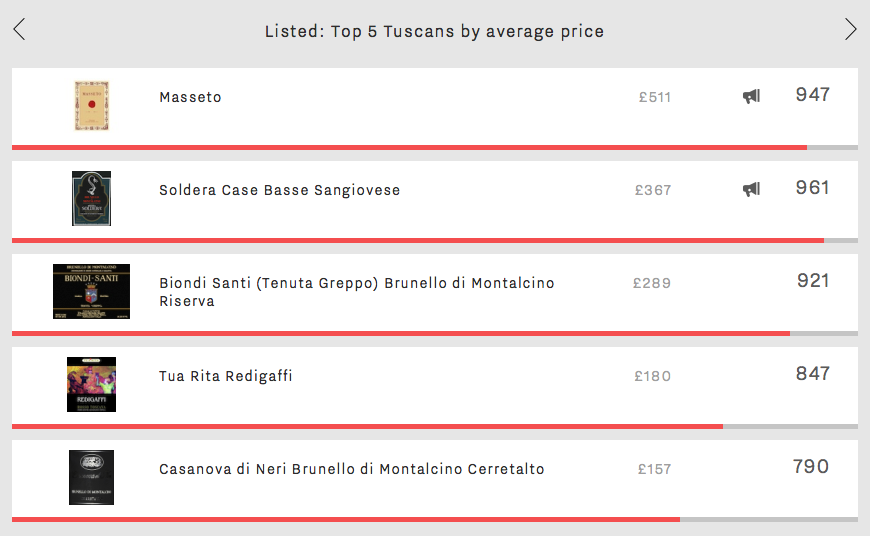
Two Brunellos feature amongst Tuscany’s most expensive wines: Biondi Santi’s Brunello Riserva (£289) and Casanova di Neri’s Brunello Cerretalto (£157). Whilst Biondi Santi Brunello Riserva’s appearance might be expected, considering its heritage, the fact that Casanova di Neri Cerretalto is amongst Tuscany’s most expensive wines might be more of a surprise, indicating that Riserva status alone does not currently guarantee higher prices than straight Brunellos.
Rounding out the five is Tuscany’s fourth-most expensive wine and the group’s second 100% merlot – Tua Rita’s Redigaffi. At an average price of £180 per bottle, it is over 2.5 times cheaper than its varietal companion in the group, Masseto.
Montevertine Le Pergole Torte is Tuscany’s top-scoring wine. Here we look at the key facts that have helped it top the Tuscan table.
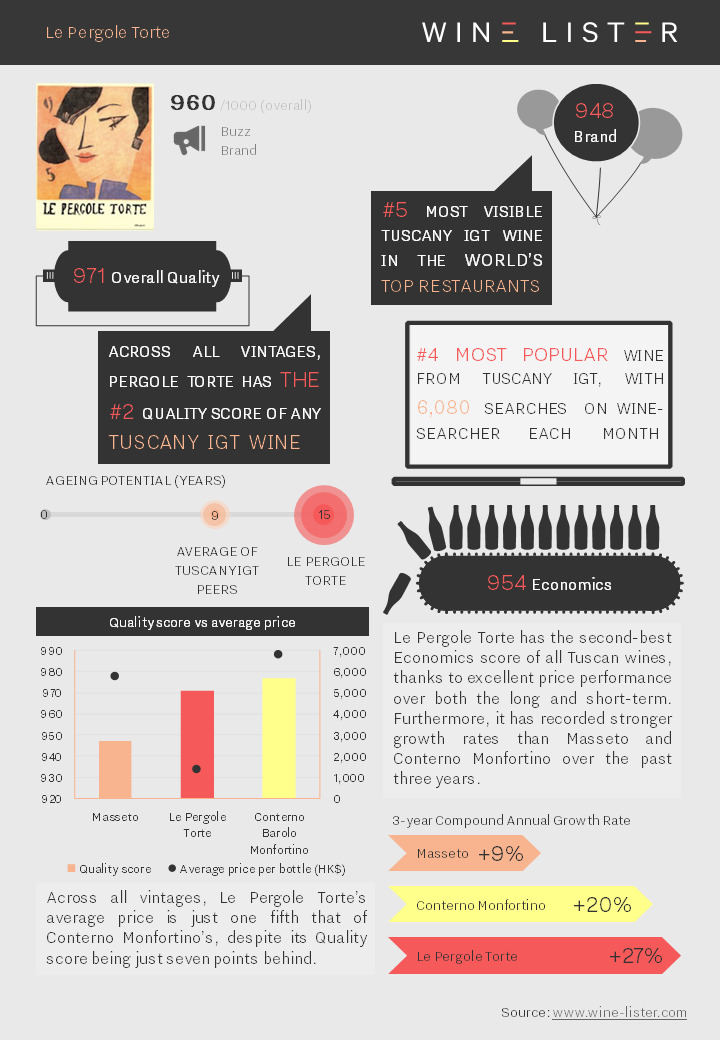
You can download this slide here: Wine Lister Factsheet Le Pergole Torte
Christmas is a time of tradition. Whether we like it or not, we tend to spend each year doing, eating, and drinking the same as we did the year before. Whilst everybody’s idea of Christmas will be personal, usually based on childhood memories, there are clearly a shared set of rituals that most of tend to follow: mince pies, turkey or goose, crackers, Christmas pudding. There are also certain styles of wine that we associate with Christmas (though these associations are probably not based on childhood memories!). We decided to look a bit further into the online popularity of specific regions and styles of wine to determine whether in fact we do all drink the same things over the festive season.
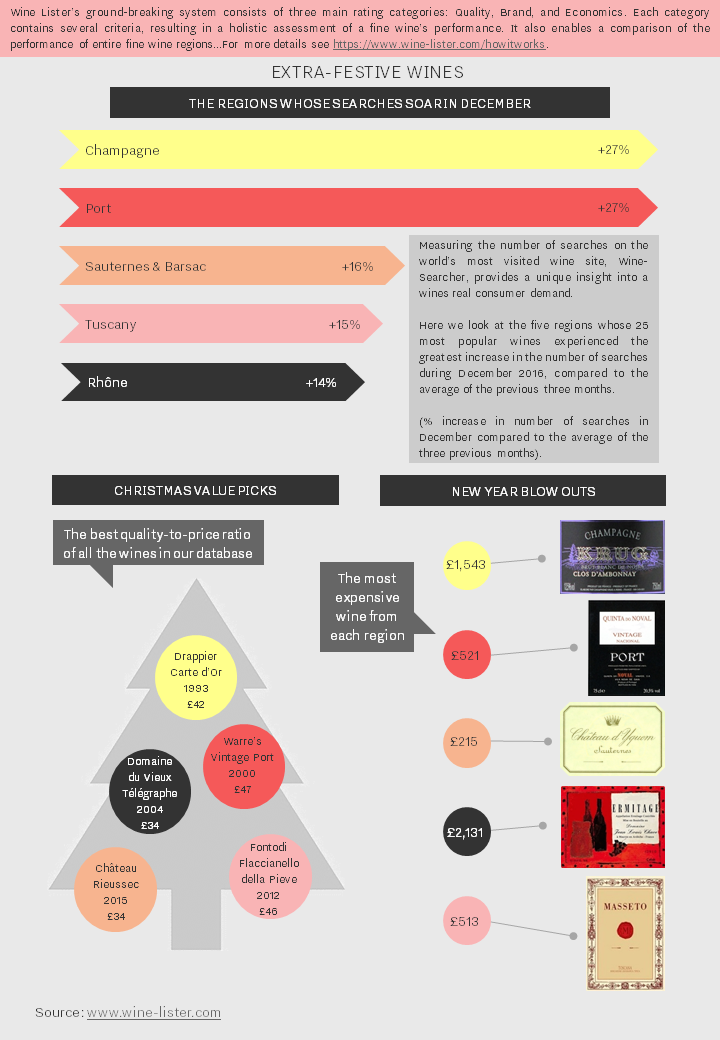
Comparing the search frequency of each region’s 25 most popular wines on Wine-Searcher during December 2016 compared to the average of the previous three months, the results are conclusive. Champagne and Port both enjoyed a dramatic surge in popularity – receiving over a quarter more searches during December. Whilst Port’s dramatic increase in online search frequency was presumably because it is the classic accompaniment to another festive favourite – Stilton – Champagne’s seasonal rise in popularity must be because it is not just the tipple of choice at Christmas parties, but also at New Year’s celebrations.
It seems that we also tend to favour the sweet whites of Sauternes and Barsac over Christmas, their 25 most popular wines enjoying a 16% increase in online search frequency. When it comes to dry reds, we appear to gravitate towards hearty styles at this time of year, with Tuscany and the Rhône also experiencing noticeable boosts in online popularity (up 15% and 14% respectively).
If you haven’t yet stocked up on those perennial favourites, Wine Lister’s Value Pick search tool can help you effortlessly find top Quality at a reasonable price. Each of our Christmas Value Picks achieves an outstanding Quality score of at least 965, putting them amongst the very best on Wine Lister. With the most expensive – Warre’s Vintage Port 2000 – available for as little as £47, they represent remarkable value.
If you are after a really special bottle for New Year’s, then we also show the most expensive wine from each region. Each of these wines qualify as Wine Lister Buzz Brands, and is sure to help start 2018 with a bang.
Download a PDF version here.
First published in French in En Magnum.
Wines featured: Drappier Carte d’Or 1993; Domaine du Vieux Télégraphe Châteauneuf-du-Pape 2004; Rieussec 2015; Fontodi Flaccianello della Pieve 2012; Krug Clos d’Ambonnay; Quinta do Noval Porto Nacional Vintage Port; Château d’Yquem; Jean-Louis Chave Hermitage Cuvée Cathelin; Masseto
Brands such as Sassicaia or Masseto are virtually household names. Known to most as ‘Super Tuscans’, the unofficial ‘Crus Classés’ of Tuscany’s IGT-elite have garnered a reputation for high quality and investment calibre over the last 20 years, and have a price tag to match.
Most would agree that the first Super Tuscan was Sassicaia, produced by Mario Incisa della Rocchetta, who planted Cabernet Sauvignon for his family’s own personal stock, before releasing it commercially from 1968.
The early Super Tuscan sought to by-pass the DOC system and rules banning international varieties. Labelled simply as ‘vino da tavola’, consumers were able to decide for themselves on the quality of the liquid in the bottle. Meanwhile, Sassicaia earnt its own DOCG in 2013, and has the strongest brand in Italy and one of the strongest in the world – but what of the rest?
Last month Wine Lister explored Italy’s top wines for Economics, and found that the economic profiles of Piedmont’s top wines (Barolo and Barbaresco), beat their Tuscan counterparts. So what can consumers expect from Tuscany, apart from an idyllic holiday destination?
The Tuscan crown for Brand scores still firmly sits on the heads of the big five (Sassicaia, Tignanello, Ornellaia, Masseto, and Solaia), but with a little more digging, exceptional quality can certainly be found beyond these few names. Indeed, eight of Wine Lister’s top 10 Italian Value Picks by Quality score come from the country’s central region:
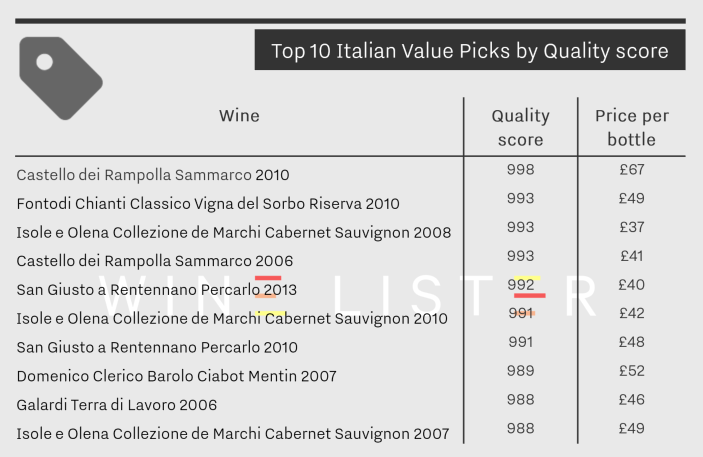
Value Picks are defined as wines with the best quality-to-price ratio, with an emphasis on quality. Of the Tuscan entries, only one is a DOCG – the Chianti Classico Vigna del Sorbo Riserva 2010 from Fontodi. The others are IGT, or ‘Super Tuscan’, such as Castello dei Rampolla Sammarco 2006 and 2010, and San Giusto a Rentannano Percarlo 2010 and 2013.
On average, Super Tuscan Value Picks cost £26 per bottle, and achieve Quality scores of 864. Meanwhile Super Tuscan Buzz Brands cost six times as much for the for an average Quality score of 889.
Whether Tuscany’s classification system will be able to define a true quality hierarchy in time is not clear. In the meantime, Wine Lister’s scoring system sheds some light on where the real value of Tuscany lies.
Also featured: Isole e Olena Collezione de Marchi Cabernet Sauvignon; Domenico Clerico Barolo Ciabot Mentin; Galardi Terra di Lavoro
Confirming the outstanding economic performance of Piedmont’s top crus, Italy’s top five wines for economics all hail from Barolo and Barbaresco. Tuscany doesn’t get a look-in. Featuring just two producers – Giacomo Conterno and Bruno Giacosa – this week’s listed section boasts wines achieving outstanding Economics scores of over 960.
Wine Lister’s Economics score combines five criteria: three-month average price, six-month-price performance, three-year compound average growth rate (CAGR), price stability, and liquidity (volume traded).
A three-month average price of £595 per bottle tips the Economics rating in favour of Giacomo Conterno’s Barolo Monfortino Riserva, which scores a mighty 978. Its three-month average price is over double that of the second-most expensive wine.
Seven points behind in second place is the Barbaresco Asili Riserva from Giacosa’s Azienda Agricola Falletto, with an Economics score of 971. Just one point behind that, in third place, with an Economics score of 970, Giacomo Conterno’s second wine to make the top five is the Barolo (Cascina) Francia. Following a slump in its score at the end of 2016, it bounced back January and continued to rise throughout the year.
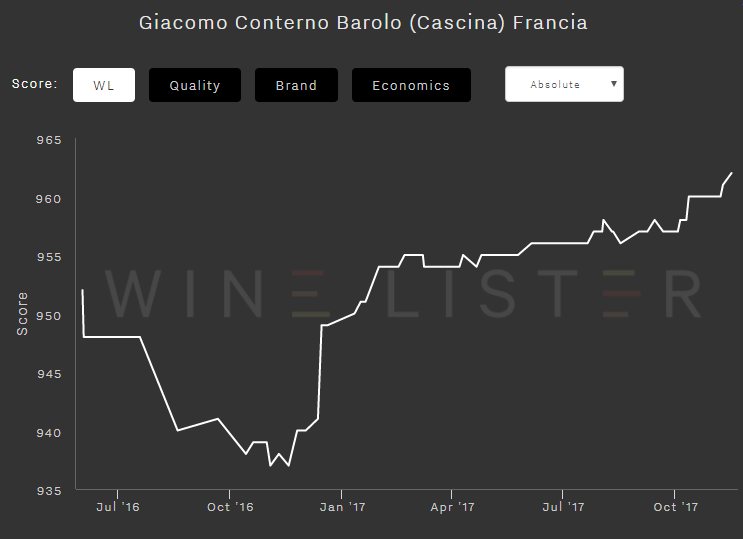
Giacosa’s Azienda Agricola Falletto Barbaresco Rabajà is fourth-highest with a score of 963. This wine has the strongest three-year CAGR of the group, at 27.5%.
Bruno Giacosa’s third entry, completing the top five with an Economics score of 963, is his Barolo Rocche Falletto Riserva. It has the highest liquidity of the group, with 500 bottles of its top five vintages traded in the past year.
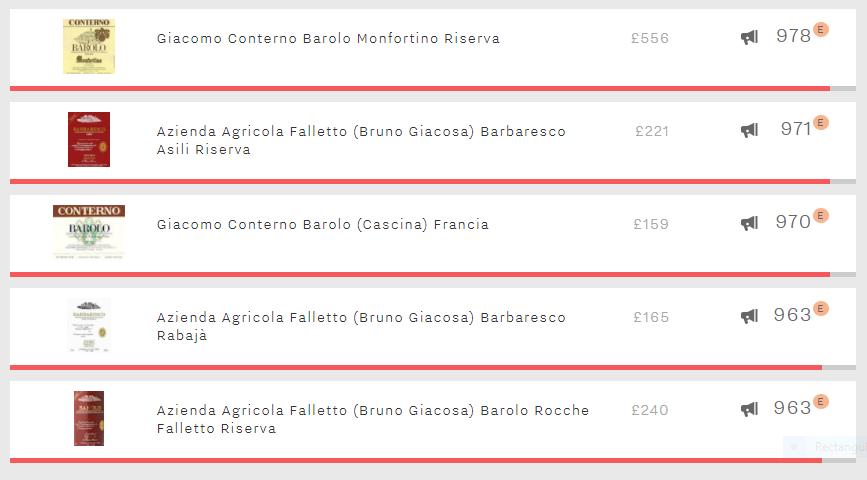
All of the top five hold Buzz Brand status, but their soaring prices equate to lower price stability across the group, averaging 8.6% standard deviation compared to 7.1% for the top five Tuscan wines by Economics score. Piedmont might offer more potential upside, but by definition this makes it riskier investment territory.












